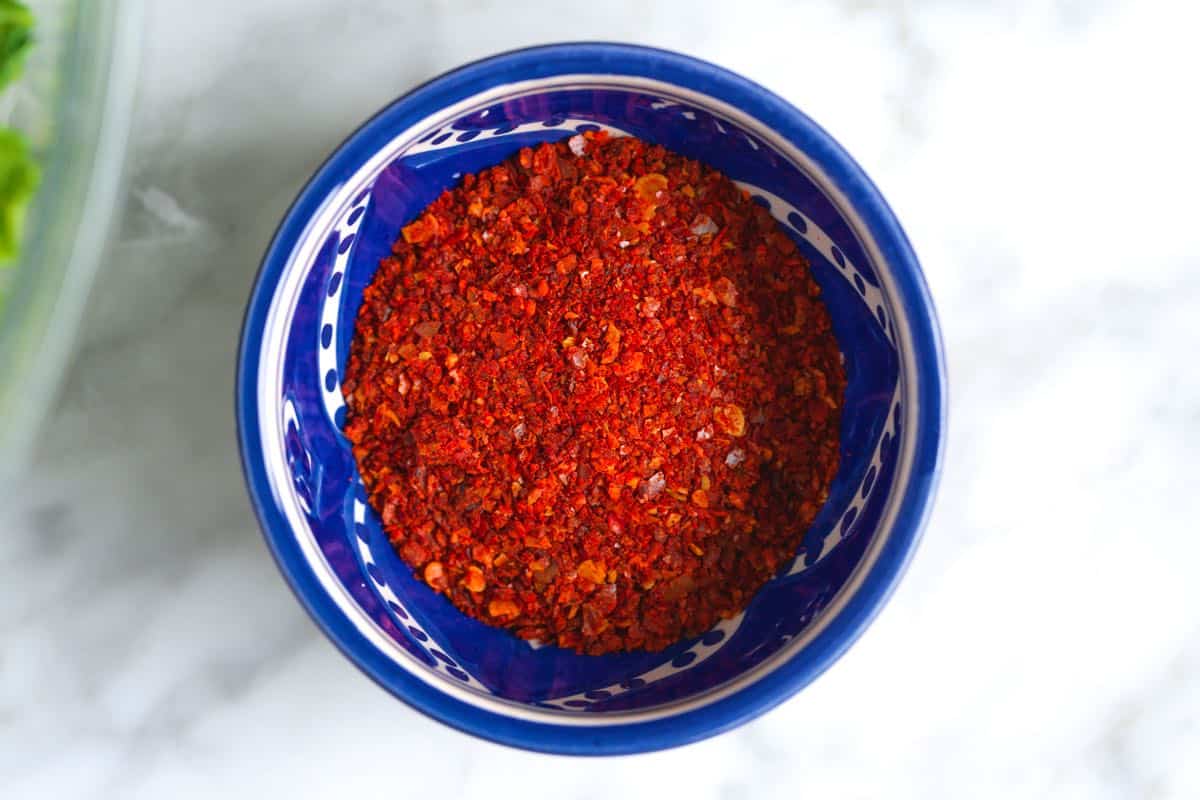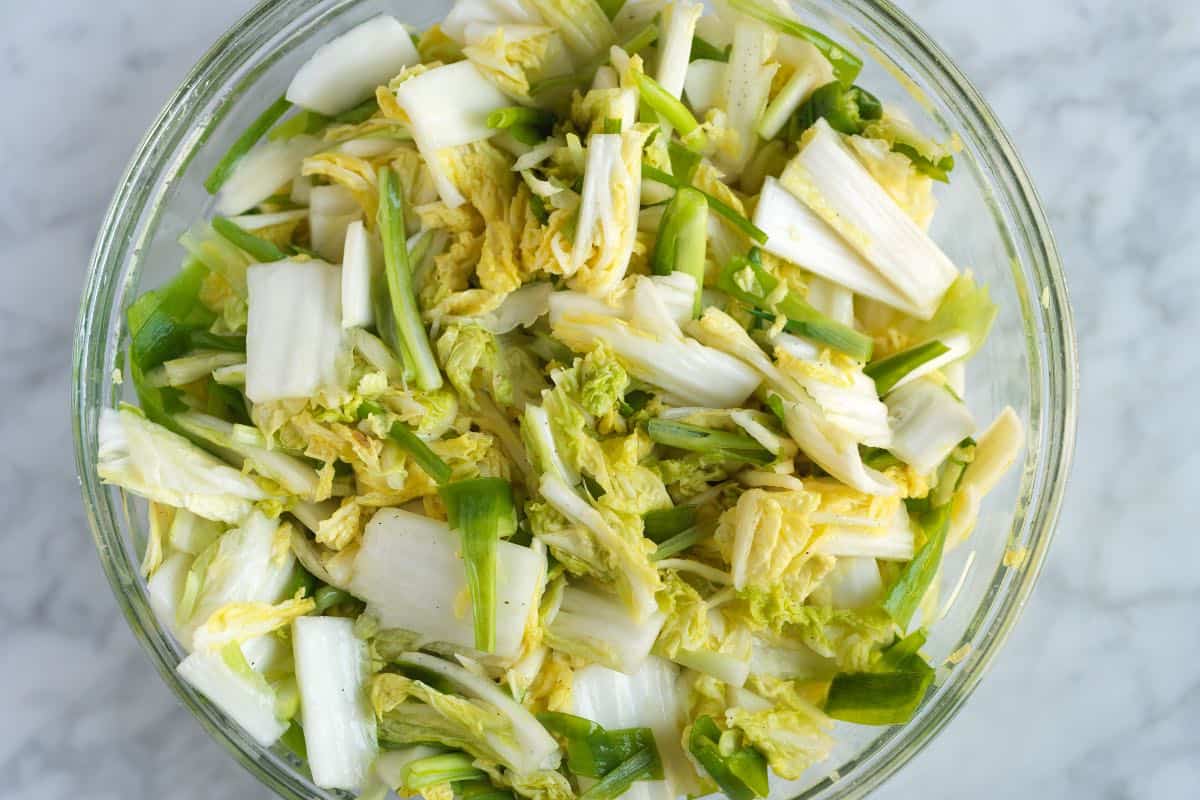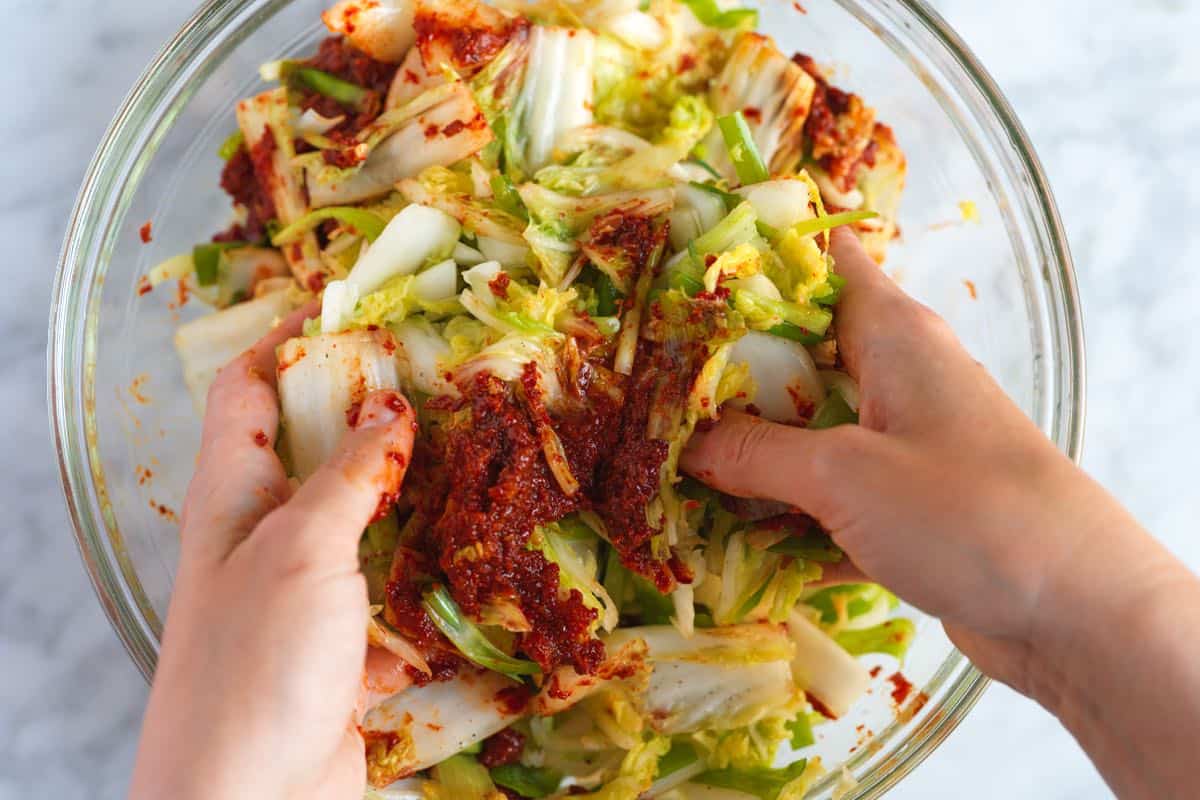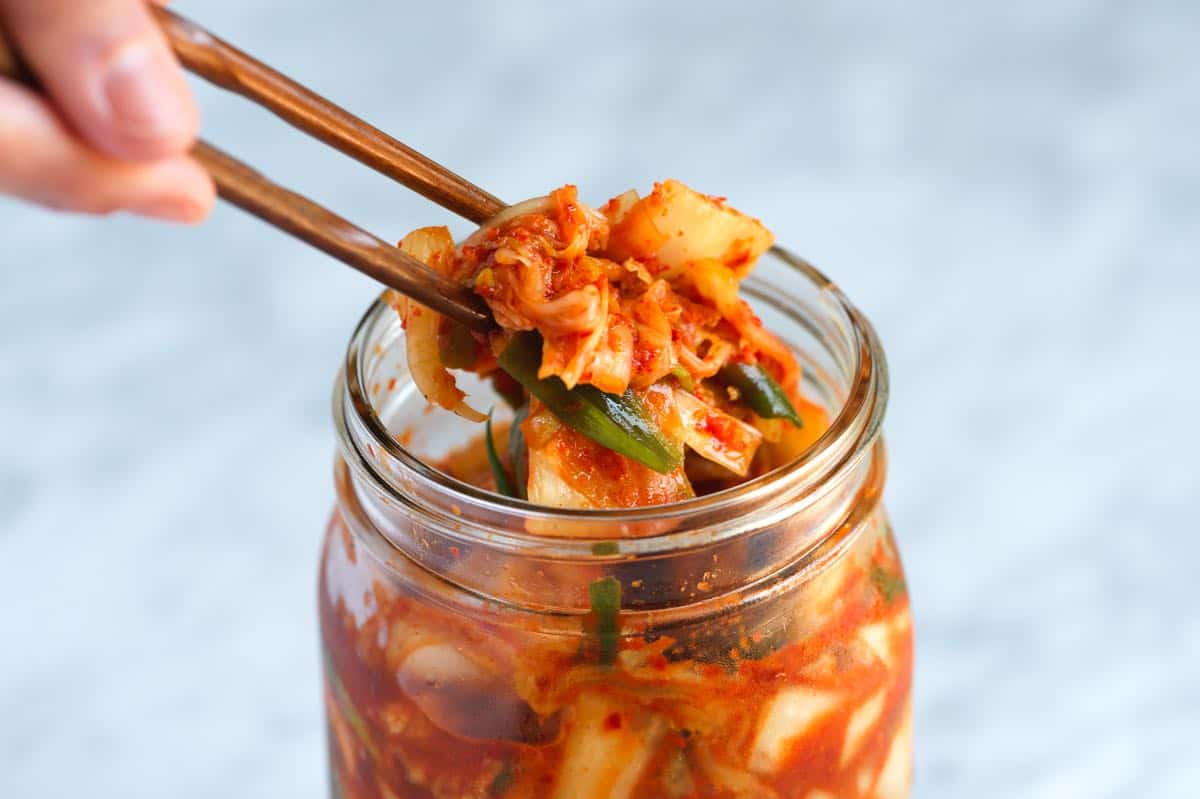Easy Kimchi Recipe

We love this beginner-friendly kimchi recipe! So if you are considering making kimchi at home, now is a great time for Go The Go! This kimchi tastes great. I added it to almost everything!
Kimchi, also spelled by Kimchee, is a beloved Korean dish made from fermented vegetables. I’m sharing a recipe for our most common types of kimchi, which is made using Napa Cabbage (Baechu). Traditionally, it has been used as a Banchan (a side dish that comes with a meal).
Kimchi is also used in kimchi fried rice, stews, dumplings, delicious pancakes and noodles. I also added it to sandwiches, wraps and salad bowls. My favorite way to enjoy kimchi at the moment is to scrambled eggs!
Key Ingredients
- cabbage: I use Napa cabbage to make kimchi because it has tender leaves during its fermentation that softens well. Its mild flavors also complement other delicious flavors in kimchi.
- Salt: The first step in making kimchi is to cut it into cabbage and add salt. Salt kills harmful bacteria and helps to pull excess water out of the cabbage. Let the cabbage sit after the salt, I rinse and drain until it is mostly dry.
- Green onion: I like to add green onions or shallots to my homemade pickles. I cut them on the larger side so I can see them after fermenting. They add fresh onion flavor and aroma.
- gochugaru: This Korean red pepper powder or flake adds heat, flavor and a vibrant red to the kimchi. I recommend using mild gochugaru because you can always add more to make the kimchi more vibrant without making it too spicy.
- Garlic and Ginger: I use a lot of fresh garlic and ginger in this recipe and like to grind them with a tiny mini platform grater. Ground garlic and ginger melt into a kimchi sauce, adding incredible flavor.
- Fish sauce: Kimchi usually includes seafood parts such as fish sauce, oysters, squid or salted shrimp paste to add an umami, rich savory flavor. We often don’t have most of what I listed, but I always have fish sauce, so I use it in this recipe.
- sugar: Sugar balances the calories of gochugaru and the season of spices and cabbage.
- Rice Thickener: While optional, rice thickener (porridge with porridge and water) helps the chili paste stick to the cabbage. It also improves the flavor and texture of the kimchi. I shared the simple steps I took below.
How to make kimchi at home
We still have a lot of knowledge about making different varieties of kimchi and we love to taste and explore other options. Our pickle recipe below is a great entry point. It can also be adjusted to your favorite spice level based on the amount of gochugaru you use (red chili powder shown in the picture below). We have made this recipe with chef Richard Hattaway. You will love it!

One of the best parts about kimchi is that it is delicious fresh (unfermented) or fermented. So you can make it in batches, enjoy some salads, and then ferment the rest in a jar in the refrigerator.
It doesn’t matter if the opinions on making kimchi the best are different. Kimchi is a traditional dish that has been adjusted in the family for centuries. This recipe is our starting point. It requires ingredients we usually offer in our area and makes us crave the type of kimchi we desire.
We need to follow when making kimchi Two basic steps:
First, cut the cabbage off and add salt. This will kill any unwanted bacteria and help pull out excess water from the cabbage. Then, after allowing the cabbage to sit with salt, we rinse and drain until mostly dry.


Secondly, massage the paste made of red pepper powder (gochugaru) and other ingredients such as garlic, ginger, fish sauce and sugar, go into cabbage. You can enjoy fresh pickles (immediately) or make it fermented. Fermentation will occur at room temperature or in the refrigerator. It is slower in the refrigerator, but fermentation in the refrigerator is our preferred method (it is available and easy).


The fermentation time of kimchi can vary according to personal preference and the required richness level. Usually, fermentation takes 2 to 3 weeks in the refrigerator.
Some people allow kimchi to ferment at room temperature for a day or longer. This speeds up your fermentation, but we prefer to slide the jar into the refrigerator and ferment it there. A little slow, but after a few weeks the fridge-fermented kimchi has the same sour, stylish notes.
In the refrigerator, pickles can usually stay fresh for several months. However, over time, its flavor and texture will continue to change gradually. Some people prefer the flavor of kimchi, and when it’s relatively fresh, some people like it. Personally, I prefer the fresh style of kimchi. Please note that our recipes below are not intended to be shelves stable (not or not placed for a long time).


Simple kimchi
-
Prepare
-
All
Our pickle recipe is beginner friendly. It’s simple and can be adjusted to your favorite spice level based on the gochugaru (red pepper powder) you use. While some recipes put cabbage in wedges, we cut our recipe into bite-sized pieces. This simplifies things during salt salt water and saves some time. We usually make cabbage-only kimchi without adding other vegetables (except garlic, ginger and green onions), but feel free to add chopped Korean radish, daikon or carrots.
Made 1 1/2 quarts
You will need
Ingredients for kimchi
1 Napa cabbage, about 3 pounds
2½ tablespoons (42g) fine sea salt
12 green onions
2 tablespoons rice thickener, recipe below
5 tablespoons (45g) gochugaru, Korean red pepper powder
8 cloves and garlic, grated
A 2-inch knob fresh ginger, finely ground
2 tablespoons fish sauce
4 teaspoons sugar
2 tablespoons water
Rice thickener
1 tablespoon sweet rice noodles
1/2 cup (118 ml) cold water
direction
1Cut the cabbage in half, cut the core off by cutting it into 1½-inch pieces. Trim the root ends of the green onions, cut them in half, and then cut them into 2-inch pieces.
2Place the cabbage and green onions in a large bowl (or two bowls if needed). Sprinkle with salt and mix well. Cover with a clean dish towel and let sit at room temperature until the cabbage is obviously wilted, about 1 to 2 hours. After 30 minutes, throw the cabbage to redistribute the salt.
3When the cabbage wilts, combine 1 tablespoon of rice flour and 1/2 cup of water in a small pot to make a rice thickener. Cook over medium heat and stir continuously until a thick paste forms. Remove from heat and cool.
4Make a chili paste by mixing gochugaru, garlic, ginger, fish sauce, sugar and water. Add 2 tablespoons of cooled rice thickener and stir until well combined. Store in the refrigerator until ready.
5After rolling, rinse the solution next to it with cold water (2 to 3 times) and then leave it aside for 20 to 30 minutes (or use a salad spinner).
Massage chili sauce into drained cabbage (consider using gloves). Continue until all the cabbage is completely covered.
6Pack the kimchi into a 1 quart jar (use a second jar or a smaller 16 oz jar if there is an extra one). Press the kimchi down until the salted water covers the cabbage, leaving at least 1 inch of space between the kimchi and the lid. If so, place the fermentation weight on top and seal the jar.
7Ferment the kimchi in the refrigerator. After a day, press the cabbage with a clean spoon to release trapped bubbles to “burn”
8Enjoy kimchi at any time! After a week or two, it will develop a fashionable, sour taste. As it ferments you may see bubbles oozing out of the jar, so consider putting the jar in a small bowl to catch anything.
Adam and Joanne’s Tips
- Vegan or vegan: Place the fish sauce in the mixture in the chili powder and add it 1 to 2 tablespoons of white or red o-sauce and massage it into the cabbage.
- Salt: Use iodine-free salt. Iodine prevents proper fermentation.
- gochugaru: Korean red pepper powder or thin slices add calories, flavor and bright red to kimchi. We used Law’s Gochugaru in our photos because it is usually used in local grocery stores. You can also find Gochugaru for sale in the international/Korea market. If you can choose between hot or mild, choose mild as you can add more and make the kimchi more vibrant without making it too spicy (Maangchi’s tip).
- Spicy kimchi: Add Gochugaru in the recipe, or use Gochugaru marked as medium or hot to make your batch. You can taste if the chili sauce is spicy when making it.
- Nutritional Facts: The nutritional facts provided below are estimates. We have used the USDA database to calculate the approximation. Please note that it is difficult to determine sodium using this recipe.
Nutrition per serving
Service size
1/2 cup
/
Calories
twenty two
/
Total fat
0.5g
/
Saturated fat
0.1g
/
cholesterol
0mg
/
sodium
283.7mg
/
carbohydrate
4.4 grams
/
Dietary fiber
1.3 g
/
Total sugar
2G
/
protein
0.9 g




